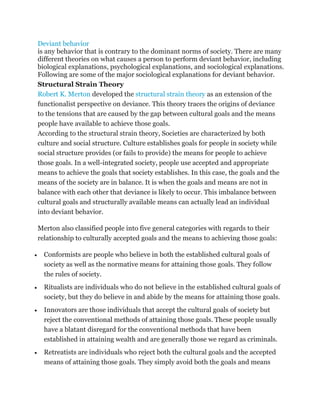
Deviant behavior
- 1. Deviant behavior is any behavior that is contrary to the dominant norms of society. There are many different theories on what causes a person to perform deviant behavior, including biological explanations, psychological explanations, and sociological explanations. Following are some of the major sociological explanations for deviant behavior. Structural Strain Theory Robert K. Merton developed the structural strain theory as an extension of the functionalist perspective on deviance. This theory traces the origins of deviance to the tensions that are caused by the gap between cultural goals and the means people have available to achieve those goals. According to the structural strain theory, Societies are characterized by both culture and social structure. Culture establishes goals for people in society while social structure provides (or fails to provide) the means for people to achieve those goals. In a well-integrated society, people use accepted and appropriate means to achieve the goals that society establishes. In this case, the goals and the means of the society are in balance. It is when the goals and means are not in balance with each other that deviance is likely to occur. This imbalance between cultural goals and structurally available means can actually lead an individual into deviant behavior. Merton also classified people into five general categories with regards to their relationship to culturally accepted goals and the means to achieving those goals: Conformists are people who believe in both the established cultural goals of society as well as the normative means for attaining those goals. They follow the rules of society. Ritualists are individuals who do not believe in the established cultural goals of society, but they do believe in and abide by the means for attaining those goals. Innovators are those individuals that accept the cultural goals of society but reject the conventional methods of attaining those goals. These people usually have a blatant disregard for the conventional methods that have been established in attaining wealth and are generally those we regard as criminals. Retreatists are individuals who reject both the cultural goals and the accepted means of attaining those goals. They simply avoid both the goals and means
- 2. established by society without replacing those norms with their own counter-cultural forces. Rebels not only reject both the established cultural goals and the accepted means of attaining those goals, but they substitute new goals and new means of attaining those goals. Labeling Theory Labeling theory is one of the most important approaches to understanding deviant and criminal behavior within sociology. Labeling theory begins with the assumption that no act is intrinsically criminal. Definitions of criminality are established by those in power through the formulation of laws and the interpretation of those laws by police, courts, and correctional institutions. Deviance is therefore not a set of characteristics of individuals or groups, but rather it is a process of interaction between deviants and non-deviants and the context in which criminality is being interpreted. Those who represent forces of law and order and those who enforce the boundaries of proper behavior, such as the police, court officials, experts, and school authorities, provide the main source of labeling. By applying labels to people, and in the process creating categories of deviance, these people are reinforcing the power structure of society. Many of the rules that define deviance and the contexts in which deviant behavior is labeled as deviant are framed by the wealthy for the poor, by men for women, by older people for younger people, and by ethnic minorities for minority groups. In other words, the more powerful and dominant groups in society create and apply deviant labels to the subordinate groups. Social Control Theory Social control theory, developed by Travis Hirschi, is a type of functionalist theorythat suggests that deviance occurs when a person’s or group’s attachment to social bonds is weakened. According to this view, people care about what others think of them and conform to social expectations because of their attachments to others and what others expect of them. Socialization is important in producing conformity to social rules and it is when this conformity is broken that deviance occurs. Social control theory focuses on how deviants are attached, or not, to common value systems and what situations break people’s commitment to
- 3. these values. This theory also suggests that most people probably feel some impulse towards deviant behavior at some time, but their attachment to social norms prevents them from actually participating in deviant behavior. Theory of Differential Association The theory of differential association is a learning theory that focuses on the processes by which individuals come to commit deviant or criminal acts. According to the theory, created by Edwin H. Sutherland, criminal behavior is learned through interactions with other people. Through this interaction and communication, people learn the values, attitudes, techniques, and motives for criminal behavior. Differential association theory emphasizes the interaction people have with their peers and others in their environment. Those who associate with delinquents, deviants, or criminals learn to value deviance. The greater the frequency, duration, and intensity of their immersion in deviant environments, the more likely it is that they will become deviant. This theory really focuses on how people become criminals, not why they become criminals.